
Warner Bruns
November 14, 2003

We got detailed technical data1 of the proposed BESSY cavity.
The technical data are transformed step by step into an inputfile for gd1. Every step is explained in detail. Numerous hints are given, how one effectively models the geometry.
 |
In the first step we model the cavity and the beam-pipes. We do this by specifying a polygonal description of the boundary in the r-z-plane. The inputfile that describes the boundary is:
#
# Some helpful symbols:
#
define(EL, 1) define(MAG, 2)
define(INF, 1000)
#
# We define symbols that will be used to describe our cavity:
# The names of the symbols can be up to 32 characters long,
#
define(OuterRadius , 46.23e-2/2 )
define(InnerRadius , 13.00e-2/2 )
define(GapLength , 27.60e-2 )
define(CurveRadius , 0.585e-2 )
define(BeamPipeRadius, 14.17e-2/2 )
define(TaperLength , 13.2e-2 )
########
#
# We fill the universe with metal
#
-brick
material= EL
xlow= -INF, xhigh= INF
ylow= -INF, yhigh= INF
zlow= -INF, zhigh= INF
doit
#
# we carve out the body of the cavity
#
-gbor
material= 0
origin= (0,0,0)
range= (0,360)
clear
#
# the following polygon describes the upper part of the cavity:
#
point= ( -1e-6, 0) # (z,r)
point= ( 0.1+0.27, 0)
point= ( 0.1+0.27, 0.037 )
point= ( 0.126, 0.037)
arc, radius= 0.01, size= small, type= clockwise
point= ( 0.116, 0.047)
arc,
point= ( 0.1207008, 0.0554805 )
point= ( 0.1595, 0.0797249 )
point= ( 0.1595, 0.1836 )
point= ( 0.1495, 0.2027 ) # 0.2027 am 7.ten November 2003
point= ( 0, 0.2027 )
point= ( -1e-6, 0 )
#
# specify the r- and z-direction of the BOR,
# model the upper part.
#
rprime= ( 1, 0, 0 )
zprime= ( 0, 0, 1 ) # Upper part of the cavity
show= later
doit
#
# re-specify the z-direction,
# model the lower part.
#
zprime= ( 0, 0, -1 ) # lower part of the cavity
show= all
doit
-volumeplot
doit
This inputfile can be found as "/usr/local/gd1/Tutorial-Bessy/bessy00.gdf".
When we feed this file into gd1 via the command
"gd1  |
gd1 does not what we want, we do not get a "volumeplot", although we requested one. But gd1 gives us a hint what we made wrong:
gbor> -volumeplot volumeplot> doit # I am checking the mesh settings.. ********* .. plane x= xlow in "-mesh" is undefined. ********* ********* .. plane x= xhigh in "-mesh" is undefined. ********* ********* "-mesh": plane pxlow is not lower than pxhigh. ********* ********* .. plane y= ylow in "-mesh" is undefined. ********* ********* .. plane y= yhigh in "-mesh" is undefined. ********* ********* "-mesh": plane pylow is not lower than pyhigh. ********* ********* .. plane z= zlow in "-mesh" is undefined. ********* ********* .. plane z= zhigh in "-mesh" is undefined. ********* ********* "-mesh": plane pzlow is not lower than pzhigh. ********* *** section -mesh: "spacing= undefined".. *** errors in "mesh".. *** Since this not seems to be an interactive session, *** I decide to treat this as a fatal error. *** Fix the input. stopWhen we say "doit" in the section "-volumeplot", gd1 tries to generate the mesh. But in order to generate the mesh, gd1 needs to know
To give gd1 the needed information, we change our inputfile. We insert the following lines somewhere before "-volumeplot":
###
### We define the borders of the computational volume,
### and we define the default mesh-spacing.
###
-mesh
spacing= InnerRadius/15
pxlow= -1.1*OuterRadius, pxhigh= 1.1*OuterRadius
pylow= -1.1*OuterRadius, pyhigh= 1.1*OuterRadius
pzlow = -(GapLength/2+TaperLength+9e-2)
pzhigh= +(GapLength/2+TaperLength+9e-2)
The so edited inputfile can be found as
"/usr/local/gd1/Tutorial-Bessy/bessy01.gdf".
When we feed gd1 with this inputfile (gd1 ![]() bessy01.gdf)
we get a screen similiar to the one shown in figure 1.4
bessy01.gdf)
we get a screen similiar to the one shown in figure 1.4
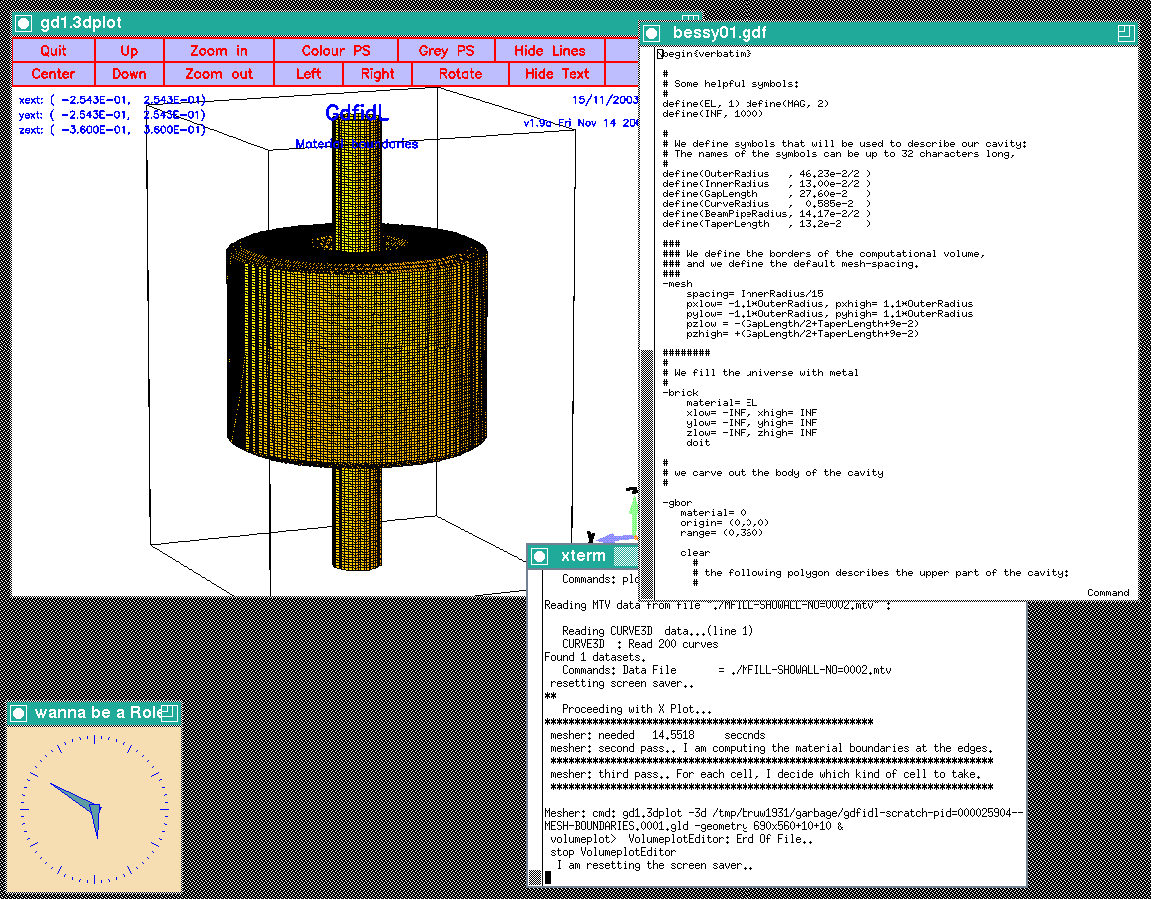 |
The hollow waveguide section is a ridged waveguide where the cross section varies continously. The waveguide is designed such, that at every cross section the cutoff frequency of the fundamental mode is the same.
The waveguides a general cylinders, where the cross section of the cylinders is some polygon. gd1 can model this directly. We edit our inputfile so that it contains:
define(GuideR0, 200e-3/2)
define(GuideGap, 42.548e-3)
define(WW, 51e-3)
define(RR2, 2e-3)
define(RR5, 5e-3)
-ggcylinder
material= 0
range= ( 0, 100e-3 )
define(AA, WW/2+RR5)
define(BB, ((GuideR0-RR5)**2 - AA**2)**0.5)
define(THETA, atan2(BB, AA))
clear
# +x, +y
point= ( GuideR0, 0 ) # x', y'
arc, radius= GuideR0, size= small, type= counterclockwise, deltaphi= 5
point= ( GuideR0*cos(THETA), GuideR0*sin(THETA) )
arc, radius= RR5, size= small, type= counterclockwise, , deltaphi= 15
point= ( WW/2 , BB )
point= ( WW/2 , GuideGap/2+ RR2 )
arc, radius= RR2, size= small, type= clockwise
point= ( WW/2-RR2 , GuideGap/2 )
# -x, +y
point= ( -(WW/2-RR2), GuideGap/2 )
arc, radius= RR2, size= small, type= clockwise
point= ( -WW/2 , GuideGap/2+ RR2 )
point= ( -WW/2 , BB )
arc, radius= RR5, size= small, type= counterclockwise, , deltaphi= 15
point= ( -GuideR0*cos(THETA), GuideR0*sin(THETA) )
arc, radius= GuideR0, size= small, type= counterclockwise, deltaphi= 5
point= ( -GuideR0, 0 ) # x', y'
# -x, -y
point= ( -GuideR0, 0 ) # x', y'
arc, radius= GuideR0, size= small, type= counterclockwise, deltaphi= 5
point= ( -GuideR0*cos(THETA), -GuideR0*sin(THETA) )
arc, radius= RR5, size= small, type= counterclockwise, , deltaphi= 15
point= ( -WW/2 , -BB )
point= ( -WW/2 , -(GuideGap/2+ RR2) )
arc, radius= RR2, size= small, type= clockwise
point= ( -(WW/2-RR2), -GuideGap/2 )
# +x, -y
point= ( (WW/2-RR2), -GuideGap/2 )
arc, radius= RR2, size= small, type= clockwise
point= ( WW/2 , -(GuideGap/2+ RR2) )
point= ( WW/2 , -BB )
arc, radius= RR5, size= small, type= counterclockwise, , deltaphi= 15
point= ( GuideR0*cos(THETA), -GuideR0*sin(THETA) )
arc, radius= GuideR0, size= small, type= counterclockwise, deltaphi= 5
point= ( GuideR0, 0 ) # x', y'
show= all
doit
The figure 1.6 shows an outline of the waveguide that
this decribes.
This waveguide has its axis gowing in z-direction.
Our waveguides shall have their axis lying in the x-y-plane,
with an angle of 0, 120 and 240 degrees.
In order to have the axis of our waveguide direct in the proper direction, we
change the values of xprimedirection, yprimedirection.
These two vectors define the local x', y' coordinate-system, in which
the foorprint of the general cylinder is described.
We edit our inputfile:
-ggcylinder
material= 0
range= ( 0, 100e-3 )
define(PHI, 120*@pi/180 )
xprimedirection= ( cos(PHI-@pi/2), sin(PHI-@pi/2), 0 )
yprimedirection= ( 0, 0, 1 )
The resulting outline is shown in figure 1.7.
macro.
Anywhere in an inputfile we can define macros.
A macro is enclosed between two lines: The first line contains the keyword
macro followed by the name of the macro.
All lines until a line with only the keyword endmacro are considered
the body of the macro.
When gd1 or gd1.pp find such a macro, they read it and store the body of the
macro in an internal buffer.
Example
#
# This defines a macro with name 'foo'
#
macro foo
echo I am foo, my first argument is @arg1
echo The total number of arguments supplied is @nargs
endmacro
When gd1 or gd1.pp find a call of the macro, the number of the supplied
arguments is assigned to the variable @nargs, and the variables
@arg1, @arg2, .. are assigned the values of the supplied parameters
of the call.
The values of the arguments are strings. Of course it is possible
to have a string eg. '1e-4' which happens to be interpreted in the
right context as a real number.
# # this calls 'foo' with the arguments 'hi', 'there' # call foo(hi, there)Macro calls may be nested. The body of a macro may call another macro.
macro Waveguide
define(Angle, @arg1) # First argument of the macro
define(ZPOSITION, @arg2) # Second argument
define(GuideR0, 200e-3/2)
define(GuideGap, 42.548e-3)
define(WW, 51e-3)
define(RR2, 2e-3)
define(RR5, 5e-3)
-ggcylinder
material= 0
range= ( 0, 100e-3 )
define(PHI, Angle*@pi/180 )
xprimedirection= ( cos(PHI-@pi/2), sin(PHI-@pi/2), 0 )
yprimedirection= ( 0, 0, 1 )
origin= ( 100*cos(PHI), 100*sin(PHI), ZPOSITION )
define(AA, WW/2+RR5)
define(BB, ((GuideR0-RR5)**2 - AA**2)**0.5)
define(THETA, atan2(BB, AA))
clear
# +x, +y
point= ( GuideR0, 0 ) # x', y'
arc, radius= GuideR0, size= small, type= counterclockwise, deltaphi= 5
point= ( GuideR0*cos(THETA), GuideR0*sin(THETA) )
arc, radius= RR5, size= small, type= counterclockwise, , deltaphi= 15
point= ( WW/2 , BB )
point= ( WW/2 , GuideGap/2+ RR2 )
arc, radius= RR2, size= small, type= clockwise
point= ( WW/2-RR2 , GuideGap/2 )
# -x, +y
point= ( -(WW/2-RR2), GuideGap/2 )
arc, radius= RR2, size= small, type= clockwise
point= ( -WW/2 , GuideGap/2+ RR2 )
point= ( -WW/2 , BB )
arc, radius= RR5, size= small, type= counterclockwise, , deltaphi= 15
point= ( -GuideR0*cos(THETA), GuideR0*sin(THETA) )
arc, radius= GuideR0, size= small, type= counterclockwise, deltaphi= 5
point= ( -GuideR0, 0 ) # x', y'
# -x, -y
point= ( -GuideR0, 0 ) # x', y'
arc, radius= GuideR0, size= small, type= counterclockwise, deltaphi= 5
point= ( -GuideR0*cos(THETA), -GuideR0*sin(THETA) )
arc, radius= RR5, size= small, type= counterclockwise, , deltaphi= 15
point= ( -WW/2 , -BB )
point= ( -WW/2 , -(GuideGap/2+ RR2) )
arc, radius= RR2, size= small, type= clockwise
point= ( -(WW/2-RR2), -GuideGap/2 )
# +x, -y
point= ( (WW/2-RR2), -GuideGap/2 )
arc, radius= RR2, size= small, type= clockwise
point= ( WW/2 , -(GuideGap/2+ RR2) )
point= ( WW/2 , -BB )
arc, radius= RR5, size= small, type= counterclockwise, , deltaphi= 15
point= ( GuideR0*cos(THETA), -GuideR0*sin(THETA) )
arc, radius= GuideR0, size= small, type= counterclockwise, deltaphi= 5
point= ( GuideR0, 0 ) # x', y'
show= all
doit
endmacro
To be able to model the complicated second part, we model the waveguide in two steps. In the first step, we fill a volume with vacuum. This volume models the waveguide without the ridge, ie it is simply a circulare waveguide where the radius varies linearly. In a second step, the volume of the ridge is refilled with electric conducting material.
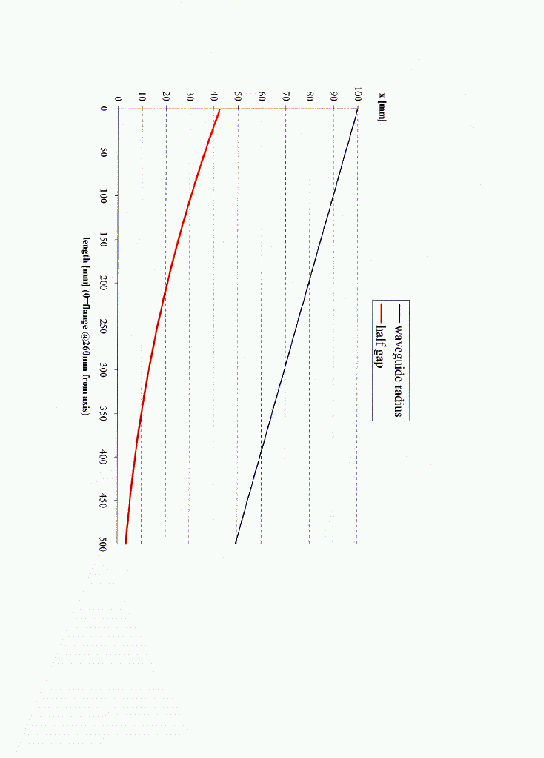 |
macro Linear_Waveguide
define(zzPHI, @arg1 *@pi/180) # First argument of the macro
define(ZPOSITION, @arg2) # Second argument
define(GuideR0, @arg4)
-ggcylinder
material= 0
range= ( @arg3, @arg5 )
xprimedirection= ( cos(zzPHI+@pi/2), sin(zzPHI+@pi/2), 0 )
yprimedirection= ( 0, 0, 1 )
origin= ( 0, 0, ZPOSITION )
xslope= (@arg6/@arg4-1)/(@arg5-@arg3)
yslope= (@arg6/@arg4-1)/(@arg5-@arg3)
clear
point= ( GuideR0, 0 ) # x', y'
arc, radius= GuideR0, size= small, type= counterclockwise, deltaphi= 5
point= ( 0, GuideR0 )
arc,
point= ( -GuideR0, 0 )
arc,
point= ( 0, -GuideR0 )
arc,
point= ( GuideR0, 0 )
show= @arg7 # now|later|all
doit
endmacro
if (0) then
#
# for example, call the macro three times:
#
do Phi= 0, 240, 120
if (Phi == 240) then
sdefine(SHOW, all)
else
sdefine(SHOW, later)
endif
call Linear_Waveguide(Phi, \ # angle
10e-3, \ # z-position
260e-3, \ # starting position of the ggcylinder
100e-3, \ # start value outer radius
(260e-3+500e-3), \ # end position of the ggcylinder
50e-3, \ # endvalue of the outer radius
SHOW )
enddo
endif
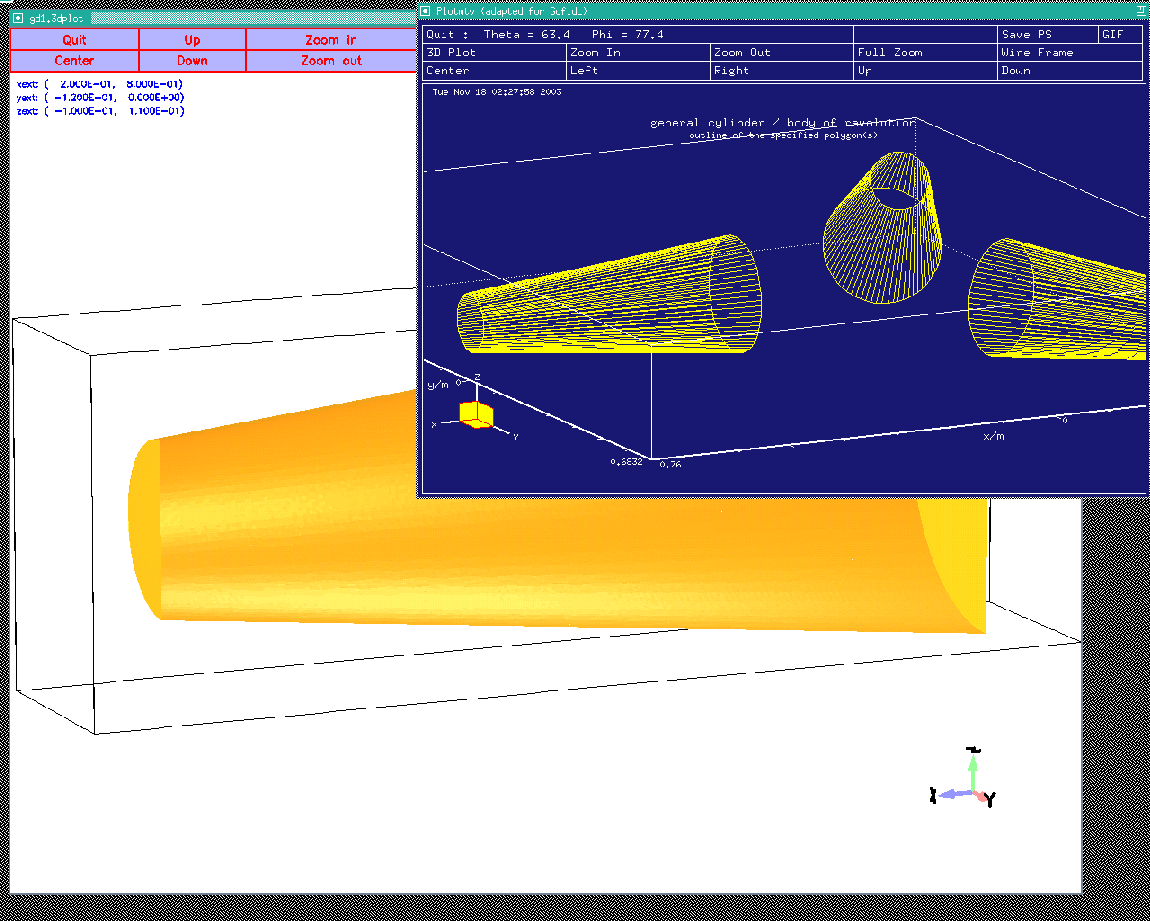 |
macro Linear_Ridge
define(zzPHI, @arg1 *@pi/180) # First argument of the macro
define(ZPOSITION, @arg2) # Second argument
define(GuideGap, 2*(@arg4) ) # @arg4 : Half starting gap
define(WW, 51e-3)
define(RR2, 2e-3)
define(RR5, 5e-3)
-ggcylinder
range= ( @arg3, @arg5 )
xprimedirection= ( cos(zzPHI+@pi/2), sin(zzPHI+@pi/2), 0 )
yprimedirection= ( 0, 0, 1 )
origin= ( 0, 0, ZPOSITION )
#
# We first refill a larger part with
# electric conducting material.
#
clear
point= ( -WW/2, -100e-3 ) # x', y'
point= ( WW/2, -100e-3 )
point= ( WW/2, 100e-3 )
point= ( -WW/2, 100e-3 )
material= 3
show= later
xslope= 0, yslope= 0
doit
#
# We now carve out the vacuum part
#
material= 0
xslope= 0
yslope= (@arg6/@arg4-1)/(@arg5-@arg3)
define(AA, WW/2+RR5)
define(BB, ((GuideR0-RR5)**2 - AA**2)**0.5)
define(THETA, atan2(BB, AA))
clear
# +x, +y
point= ( WW/2 , GuideGap/2+ RR2 )
arc, radius= RR2, size= small, type= clockwise
point= ( WW/2-RR2 , GuideGap/2 )
# -x, +y
point= ( -(WW/2-RR2), GuideGap/2 )
arc, radius= RR2, size= small, type= clockwise
point= ( -WW/2 , GuideGap/2+ RR2 )
# -x, -y
point= ( -WW/2 , -(GuideGap/2+ RR2) )
arc, radius= RR2, size= small, type= clockwise
point= ( -(WW/2-RR2), -GuideGap/2 )
# +x, -y
point= ( (WW/2-RR2), -GuideGap/2 )
arc, radius= RR2, size= small, type= clockwise
point= ( WW/2 , -(GuideGap/2+ RR2) )
show= @arg7 # now|later|all
doit
endmacro
#
# Call the macro for example like this:
#
if (0) then
call Linear_Ridge(0, \ # angle
10e-3, \ # z-position
260e-3, \ # starting position of the ggcylinder
43e-3, \ # start value half gap
(260e-3+500e-3), \ # end position of the ggcylinder
9e-3, \ # endvalue of half gap
all )
endif
When we call the macro after the linear varying waveguide has been modeled,
we get a plot similiar to the one shown in figure 2.3.
The used inputfile is:
-brick
material= 3
volume= ( -INF,INF, -INF,INF, -INF,INF )
doit
include( macro-Linear_Waveguide.gdf )
include( macro-Linear_Ridge.gdf )
#
# Call the macros three times:
#
do Phi= 0, 240, 120
if (Phi == 240) then
sdefine(SHOW, all)
else
sdefine(SHOW, later)
endif
call Linear_Waveguide(Phi, \ # angle
10e-3, \ # z-position
260e-3, \ # starting position of the ggcylinder
100e-3, \ # start value outer radius
(260e-3+500e-3), \ # end position of the ggcylinder
50e-3, \ # endvalue of the outer radius
later )
call Linear_Ridge(Phi, \ # angle
10e-3, \ # z-position
260e-3, \ # starting position of the ggcylinder
43e-3, \ # start value half gap
(260e-3+500e-3), \ # end position of the ggcylinder
9e-3, \ # endvalue of half gap
SHOW )
enddo
-mesh
perfectmesh= yes
spacing= 2e-3
pxlow= 0.2, pxhigh= 0.8
pylow= -0.12, pyhigh= 0
pzlow= -0.1, pzhigh= 0.11
-volumeplot
doit
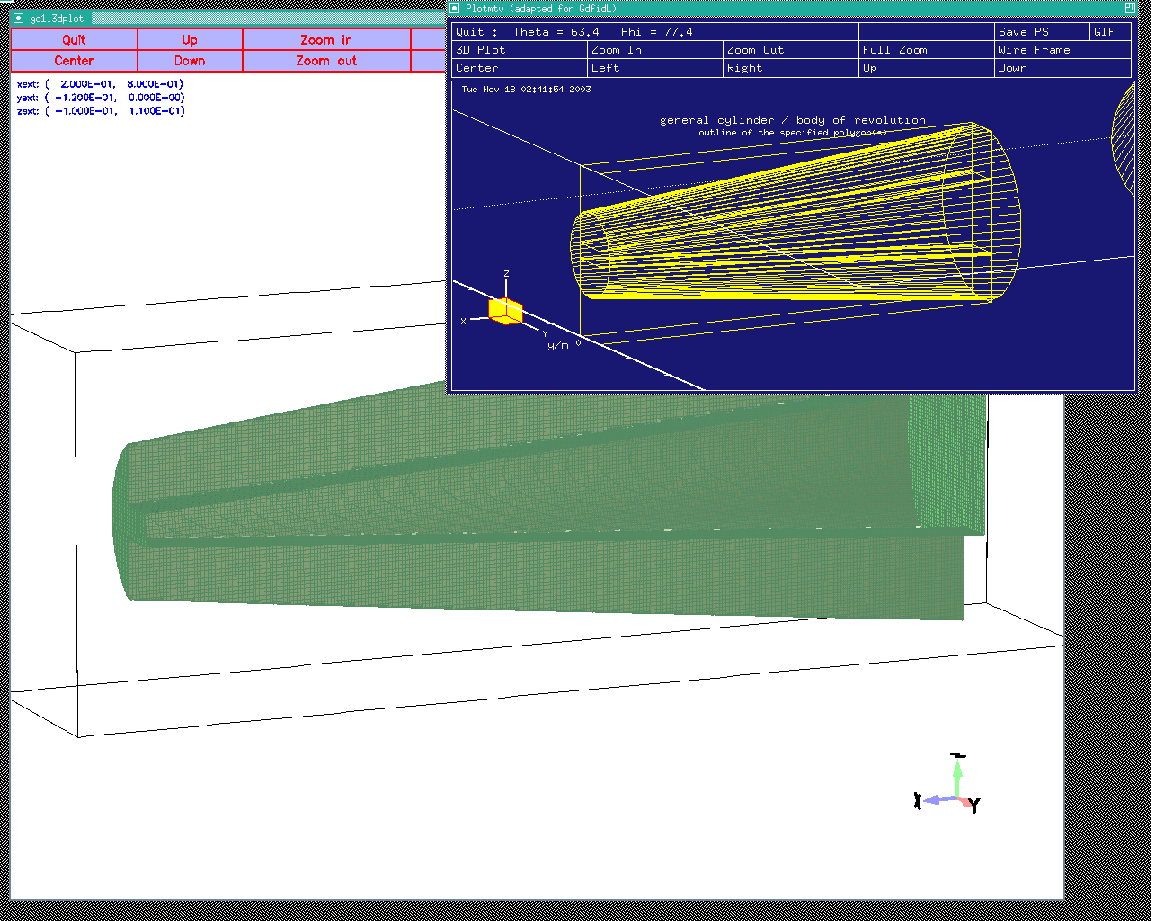 |
Since the real ridgevaries nonlinearly, we now have to call the macro many times with the proper start and end values. The wanted gap-widths as a function position can be taken from the dataset provided by Dr Marhauser:
1. Waveguide Position 2. Waveguide Radius 3. Half Gap-distance 4. Distance measured from Cavity-adapter 5. Distance measured from Cavity-center 0 100 42.548 115 375 10 98.98448 41.2529 125 385 20 97.96896 39.9786 135 395 30 96.95344 38.7253 145 405 40 95.93792 37.4932 155 415 50 94.9224 36.2822 165 425 60 93.90688 35.0925 175 435 70 92.89136 33.9242 185 445 80 91.87584 32.7772 195 455 90 90.86032 31.6517 205 465 100 89.8448 30.5478 215 475 110 88.82928 29.4654 225 485 120 87.81376 28.4046 235 495 130 86.79824 27.3812 245 505 140 85.78272 26.3479 255 515 150 84.76720 25.3521 265 525 160 83.75168 24.378 275 535 170 82.73616 23.4255 285 545 180 81.72064 22.4947 295 555 190 80.70512 21.5856 305 565 200 79.68960 20.6981 315 575 210 78.67408 19.8322 325 585 220 77.65856 18.9879 335 595 230 76.64304 18.165 345 605 240 75.62752 17.3635 355 615 250 74.61200 16.5834 365 625 260 73.59648 15.8246 375 635 270 72.58096 15.0868 385 645 280 71.56544 14.3701 395 655 290 70.54992 13.6743 405 665 300 69.53440 12.9992 415 675 310 68.51888 12.3448 425 685 320 67.50336 11.7107 435 695 330 66.48784 11.0969 445 705 340 65.47232 10.5031 455 715 350 64.45680 9.92909 465 725 360 63.44128 9.3747 475 735 370 62.42576 8.83965 485 745 380 61.41024 8.32367 495 755 390 60.39472 7.82648 505 765 400 59.37920 7.3478 515 775 410 58.36368 6.88729 525 785 420 57.34816 6.44464 535 795 430 56.33264 6.01949 545 805 440 55.31712 5.61147 555 815 450 54.30160 5.22019 565 825 460 53.28608 4.84526 575 835 470 52.27056 4.48623 585 845 480 51.25504 4.14267 595 855 490 50.23952 3.8141 605 865 500 49.22400 3.5000 615 875We can generate the needed calls to our function via a short program tha reads this dataset and then writes the appropriate file:
! This is a small Fortran program which generates
! the appropriate calls.
DO i= 1, 5
READ (*,*) ! Skip the first five lines
ENDDO
DO
READ (*,*) WPos, WRadius, HGap, DistAdapt, DistanceCenter
WRITE (*,50) DistanceCenter*1e-3, HGap*1e-3
WRITE (*,60) DistanceCenter*1e-3
WRITE (*,70) HGap*1e-3
ENDDO
50 FORMAT(' call Linear_Ridge(Phi, ZPOS,', &
G17.7,', ', G17.7,', POS_OLD, G_OLD, later )')
60 FORMAT(' ')
70 FORMAT(' ')
END
The inputfile with the automaticalls generated calls:
-brick
material= 3
volume= ( -INF,INF, -INF,INF, -INF,INF )
doit
include( macro-Linear_Waveguide.gdf )
include( macro-Linear_Ridge.gdf )
#
# Call the macros three times:
#
do Phi= 0, 240, 120
if (Phi == 240) then
sdefine(SHOW, all)
else
sdefine(SHOW, later)
endif
define(ZPOS, 10e-3)
#
# constant radius section:
#
call Linear_Waveguide(Phi, \ # angle
ZPOS, \ # z-position
200e-3, \ # starting position of the ggcylinder
100e-3, \ # start value outer radius
375e-3, \ # end position of the ggcylinder
100e-3, \ # endvalue of the outer radius
later )
#
# linear varying section:
#
call Linear_Waveguide(Phi, \ # angle
ZPOS, \ # z-position
375e-3, \ # starting position of the ggcylinder
100e-3, \ # start value outer radius
(375e-3+500e-3), \ # end position of the ggcylinder
50e-3, \ # endvalue of the outer radius
later )
define(POS_OLD, 0.200000 ) # inserted by hand
define(G_OLD, 0.4254800E-01 ) # inserted by hand
#
# The automatically generated part of the inputfile:
#
call Linear_Ridge(Phi, ZPOS, 0.2600000 , 0.4254800E-01, POS_OLD, G_OLD, later )
define(POS_OLD, 0.2600000 )
define(G_OLD, 0.4254800E-01 )
call Linear_Ridge(Phi, ZPOS, 0.2700000 , 0.4125290E-01, POS_OLD, G_OLD, later )
define(POS_OLD, 0.2700000 )
define(G_OLD, 0.4125290E-01 )
call Linear_Ridge(Phi, ZPOS, 0.2800000 , 0.3997860E-01, POS_OLD, G_OLD, later )
define(POS_OLD, 0.2800000 )
define(G_OLD, 0.3997860E-01 )
call Linear_Ridge(Phi, ZPOS, 0.2900000 , 0.3872530E-01, POS_OLD, G_OLD, later )
define(POS_OLD, 0.2900000 )
define(G_OLD, 0.3872530E-01 )
call Linear_Ridge(Phi, ZPOS, 0.3000000 , 0.3749320E-01, POS_OLD, G_OLD, later )
define(POS_OLD, 0.3000000 )
define(G_OLD, 0.3749320E-01 )
call Linear_Ridge(Phi, ZPOS, 0.3100000 , 0.3628220E-01, POS_OLD, G_OLD, later )
define(POS_OLD, 0.3100000 )
define(G_OLD, 0.3628220E-01 )
call Linear_Ridge(Phi, ZPOS, 0.3200000 , 0.3509250E-01, POS_OLD, G_OLD, later )
define(POS_OLD, 0.3200000 )
define(G_OLD, 0.3509250E-01 )
call Linear_Ridge(Phi, ZPOS, 0.3300000 , 0.3392420E-01, POS_OLD, G_OLD, later )
define(POS_OLD, 0.3300000 )
define(G_OLD, 0.3392420E-01 )
call Linear_Ridge(Phi, ZPOS, 0.3400000 , 0.3277720E-01, POS_OLD, G_OLD, later )
define(POS_OLD, 0.3400000 )
define(G_OLD, 0.3277720E-01 )
call Linear_Ridge(Phi, ZPOS, 0.3500000 , 0.3165170E-01, POS_OLD, G_OLD, later )
define(POS_OLD, 0.3500000 )
define(G_OLD, 0.3165170E-01 )
call Linear_Ridge(Phi, ZPOS, 0.3600000 , 0.3054780E-01, POS_OLD, G_OLD, later )
define(POS_OLD, 0.3600000 )
define(G_OLD, 0.3054780E-01 )
call Linear_Ridge(Phi, ZPOS, 0.3700000 , 0.2946540E-01, POS_OLD, G_OLD, later )
define(POS_OLD, 0.3700000 )
define(G_OLD, 0.2946540E-01 )
call Linear_Ridge(Phi, ZPOS, 0.3800000 , 0.2840460E-01, POS_OLD, G_OLD, later )
define(POS_OLD, 0.3800000 )
define(G_OLD, 0.2840460E-01 )
call Linear_Ridge(Phi, ZPOS, 0.3900000 , 0.2738120E-01, POS_OLD, G_OLD, later )
define(POS_OLD, 0.3900000 )
define(G_OLD, 0.2738120E-01 )
call Linear_Ridge(Phi, ZPOS, 0.4000000 , 0.2634790E-01, POS_OLD, G_OLD, later )
define(POS_OLD, 0.4000000 )
define(G_OLD, 0.2634790E-01 )
call Linear_Ridge(Phi, ZPOS, 0.4100000 , 0.2535210E-01, POS_OLD, G_OLD, later )
define(POS_OLD, 0.4100000 )
define(G_OLD, 0.2535210E-01 )
call Linear_Ridge(Phi, ZPOS, 0.4200000 , 0.2437800E-01, POS_OLD, G_OLD, later )
define(POS_OLD, 0.4200000 )
define(G_OLD, 0.2437800E-01 )
call Linear_Ridge(Phi, ZPOS, 0.4300000 , 0.2342550E-01, POS_OLD, G_OLD, later )
define(POS_OLD, 0.4300000 )
define(G_OLD, 0.2342550E-01 )
call Linear_Ridge(Phi, ZPOS, 0.4400000 , 0.2249470E-01, POS_OLD, G_OLD, later )
define(POS_OLD, 0.4400000 )
define(G_OLD, 0.2249470E-01 )
call Linear_Ridge(Phi, ZPOS, 0.4500000 , 0.2158560E-01, POS_OLD, G_OLD, later )
define(POS_OLD, 0.4500000 )
define(G_OLD, 0.2158560E-01 )
call Linear_Ridge(Phi, ZPOS, 0.4600000 , 0.2069810E-01, POS_OLD, G_OLD, later )
define(POS_OLD, 0.4600000 )
define(G_OLD, 0.2069810E-01 )
call Linear_Ridge(Phi, ZPOS, 0.4700000 , 0.1983220E-01, POS_OLD, G_OLD, later )
define(POS_OLD, 0.4700000 )
define(G_OLD, 0.1983220E-01 )
call Linear_Ridge(Phi, ZPOS, 0.4800000 , 0.1898790E-01, POS_OLD, G_OLD, later )
define(POS_OLD, 0.4800000 )
define(G_OLD, 0.1898790E-01 )
call Linear_Ridge(Phi, ZPOS, 0.4900000 , 0.1816500E-01, POS_OLD, G_OLD, later )
define(POS_OLD, 0.4900000 )
define(G_OLD, 0.1816500E-01 )
call Linear_Ridge(Phi, ZPOS, 0.5000000 , 0.1736350E-01, POS_OLD, G_OLD, later )
define(POS_OLD, 0.5000000 )
define(G_OLD, 0.1736350E-01 )
call Linear_Ridge(Phi, ZPOS, 0.5100001 , 0.1658340E-01, POS_OLD, G_OLD, later )
define(POS_OLD, 0.5100001 )
define(G_OLD, 0.1658340E-01 )
call Linear_Ridge(Phi, ZPOS, 0.5200000 , 0.1582460E-01, POS_OLD, G_OLD, later )
define(POS_OLD, 0.5200000 )
define(G_OLD, 0.1582460E-01 )
call Linear_Ridge(Phi, ZPOS, 0.5300000 , 0.1508680E-01, POS_OLD, G_OLD, later )
define(POS_OLD, 0.5300000 )
define(G_OLD, 0.1508680E-01 )
call Linear_Ridge(Phi, ZPOS, 0.5400000 , 0.1437010E-01, POS_OLD, G_OLD, later )
define(POS_OLD, 0.5400000 )
define(G_OLD, 0.1437010E-01 )
call Linear_Ridge(Phi, ZPOS, 0.5500000 , 0.1367430E-01, POS_OLD, G_OLD, later )
define(POS_OLD, 0.5500000 )
define(G_OLD, 0.1367430E-01 )
call Linear_Ridge(Phi, ZPOS, 0.5600000 , 0.1299920E-01, POS_OLD, G_OLD, later )
define(POS_OLD, 0.5600000 )
define(G_OLD, 0.1299920E-01 )
call Linear_Ridge(Phi, ZPOS, 0.5700001 , 0.1234480E-01, POS_OLD, G_OLD, later )
define(POS_OLD, 0.5700001 )
define(G_OLD, 0.1234480E-01 )
call Linear_Ridge(Phi, ZPOS, 0.5800000 , 0.1171070E-01, POS_OLD, G_OLD, later )
define(POS_OLD, 0.5800000 )
define(G_OLD, 0.1171070E-01 )
call Linear_Ridge(Phi, ZPOS, 0.5900000 , 0.1109690E-01, POS_OLD, G_OLD, later )
define(POS_OLD, 0.5900000 )
define(G_OLD, 0.1109690E-01 )
call Linear_Ridge(Phi, ZPOS, 0.6000000 , 0.1050310E-01, POS_OLD, G_OLD, later )
define(POS_OLD, 0.6000000 )
define(G_OLD, 0.1050310E-01 )
call Linear_Ridge(Phi, ZPOS, 0.6100000 , 0.9929090E-02, POS_OLD, G_OLD, later )
define(POS_OLD, 0.6100000 )
define(G_OLD, 0.9929090E-02 )
call Linear_Ridge(Phi, ZPOS, 0.6200000 , 0.9374700E-02, POS_OLD, G_OLD, later )
define(POS_OLD, 0.6200000 )
define(G_OLD, 0.9374700E-02 )
call Linear_Ridge(Phi, ZPOS, 0.6300001 , 0.8839651E-02, POS_OLD, G_OLD, later )
define(POS_OLD, 0.6300001 )
define(G_OLD, 0.8839651E-02 )
call Linear_Ridge(Phi, ZPOS, 0.6400000 , 0.8323670E-02, POS_OLD, G_OLD, later )
define(POS_OLD, 0.6400000 )
define(G_OLD, 0.8323670E-02 )
call Linear_Ridge(Phi, ZPOS, 0.6500000 , 0.7826480E-02, POS_OLD, G_OLD, later )
define(POS_OLD, 0.6500000 )
define(G_OLD, 0.7826480E-02 )
call Linear_Ridge(Phi, ZPOS, 0.6600000 , 0.7347800E-02, POS_OLD, G_OLD, later )
define(POS_OLD, 0.6600000 )
define(G_OLD, 0.7347800E-02 )
call Linear_Ridge(Phi, ZPOS, 0.6700000 , 0.6887290E-02, POS_OLD, G_OLD, later )
define(POS_OLD, 0.6700000 )
define(G_OLD, 0.6887290E-02 )
call Linear_Ridge(Phi, ZPOS, 0.6800000 , 0.6444640E-02, POS_OLD, G_OLD, later )
define(POS_OLD, 0.6800000 )
define(G_OLD, 0.6444640E-02 )
call Linear_Ridge(Phi, ZPOS, 0.6900001 , 0.6019490E-02, POS_OLD, G_OLD, later )
define(POS_OLD, 0.6900001 )
define(G_OLD, 0.6019490E-02 )
call Linear_Ridge(Phi, ZPOS, 0.7000000 , 0.5611470E-02, POS_OLD, G_OLD, later )
define(POS_OLD, 0.7000000 )
define(G_OLD, 0.5611470E-02 )
call Linear_Ridge(Phi, ZPOS, 0.7100000 , 0.5220190E-02, POS_OLD, G_OLD, later )
define(POS_OLD, 0.7100000 )
define(G_OLD, 0.5220190E-02 )
call Linear_Ridge(Phi, ZPOS, 0.7200000 , 0.4845260E-02, POS_OLD, G_OLD, later )
define(POS_OLD, 0.7200000 )
define(G_OLD, 0.4845260E-02 )
call Linear_Ridge(Phi, ZPOS, 0.7300000 , 0.4486230E-02, POS_OLD, G_OLD, later )
define(POS_OLD, 0.7300000 )
define(G_OLD, 0.4486230E-02 )
call Linear_Ridge(Phi, ZPOS, 0.7400000 , 0.4142670E-02, POS_OLD, G_OLD, later )
define(POS_OLD, 0.7400000 )
define(G_OLD, 0.4142670E-02 )
call Linear_Ridge(Phi, ZPOS, 0.7500001 , 0.3814100E-02, POS_OLD, G_OLD, later )
define(POS_OLD, 0.7500001 )
define(G_OLD, 0.3814100E-02 )
call Linear_Ridge(Phi, ZPOS, 0.7600001 , 0.3500000E-02, POS_OLD, G_OLD, SHOW )
define(POS_OLD, 0.7600001 )
define(G_OLD, 0.3500000E-02 )
enddo
-mesh
perfectmesh= yes
spacing= 2e-3
pxlow= 0.19, pxhigh= 0.8
pylow= -0.12, pyhigh= 0
pzlow= -0.1, pzhigh= 0.11
-volumeplot
doit
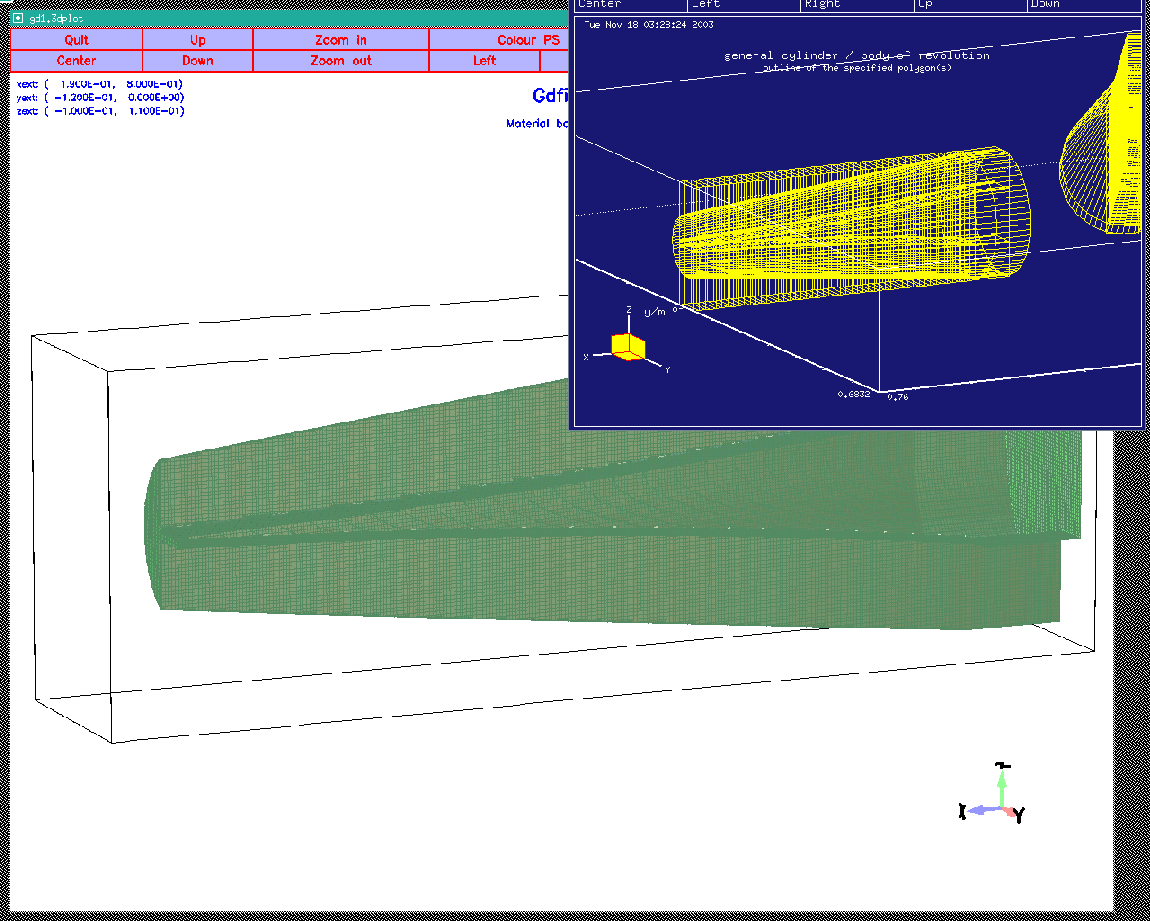 |
macro transformer
define(zzPHI, (@arg1)*@pi/180 )
define(ZOFF, @arg2)
define(RALT, 50e-3) # The last radius
-ggcyl
material= 1
xprime= ( cos(zzPHI ), sin(zzPHI ), 0 )
yprime= ( cos(zzPHI+@pi/2), sin(zzPHI+@pi/2), 0 )
xslope= 0, yslope= 0
define(RR, 906.0e-3 - 31e-3)
echo *** r-Position of tip of ellipse: eval(RR+31e-3) ( should be 906.0e-3 )
origin= ( RR*cos(zzPHI), RR*sin(zzPHI), ZOFF )
clear
point= ( 0, -51e-3/2 )
ellipse, center= ( 0, 0 ), size= small
point= ( 31e-3, 0 )
ellipse
point= ( 0, 51e-3/2 )
range= ( 3.5e-3, RALT )
show= later
doit
range= ( -RALT, -3.5e-3 )
show= @arg3
doit
endmacro
if (0) then
#
# Call this macro eg like this:
#
call transformer(0, 0, later )
endif
The coaxial waveguides are easily described as circular cylinders. In the first step, a circular cylinder is carved out with a radius of the outer conductor. In the second step, the volume of the inner conductor is refilled. We add these cylinders to the previous macro and get:
macro transformer_and_coaxial
define(zzPHI, (@arg1)*@pi/180 )
define(ZOFF, @arg2)
define(RALT, 50e-3) # The last radius
-ggcyl
material= 3
xprime= ( cos(zzPHI ), sin(zzPHI ), 0 )
yprime= ( cos(zzPHI+@pi/2), sin(zzPHI+@pi/2), 0 )
xslope= 0, yslope= 0
define(RR, 906.0e-3 - 31e-3)
echo *** r-Position of tip of ellipse: eval(RR+31e-3) ( should be 906.0e-3 )
origin= ( RR*cos(zzPHI), RR*sin(zzPHI), ZOFF )
clear
point= ( 0, -51e-3/2 )
ellipse, center= ( 0, 0 ), size= small
point= ( 31e-3, 0 )
ellipse
point= ( 0, 51e-3/2 )
range= ( 3.5e-3, RALT )
show= later
doit
range= ( -RALT, -3.5e-3 )
show= @arg3
doit
#
# The coaxial line:
#
### r-Position of coaxial lines:
define(RR, 894.2e-3-19.2e-3)
define(XOFF, (RR+19.2e-3)*cos(zzPHI) )
define(YOFF, (RR+19.2e-3)*sin(zzPHI) )
-mesh
zfixed( 2, -3.5e-3+ZOFF, 3.5+ZOFF )
xfixed( 3, XOFF-19.4e-3, XOFF- 8.4e-3 )
yfixed( 3, YOFF-19.4e-3, YOFF- 8.4e-3 )
xfixed( 3, XOFF+ 8.4e-3, XOFF+19.4e-3 )
yfixed( 3, YOFF+ 8.4e-3, YOFF+19.4e-3 )
-gccylinder
length= INF
origin= ( XOFF, YOFF, ZOFF-3.5e-3 )
direction= ( 0, 0, 1 )
material= 0, radius= 19.4e-3/2, doit # Carve out radius of outer conductor
origin= ( XOFF, YOFF, ZOFF-4.5e-3 )
material= 4, radius= 8.4e-3/2, doit # Refill inner conductor
endmacro
# call transformer_and_coaxial(Phi, Zpos, later)
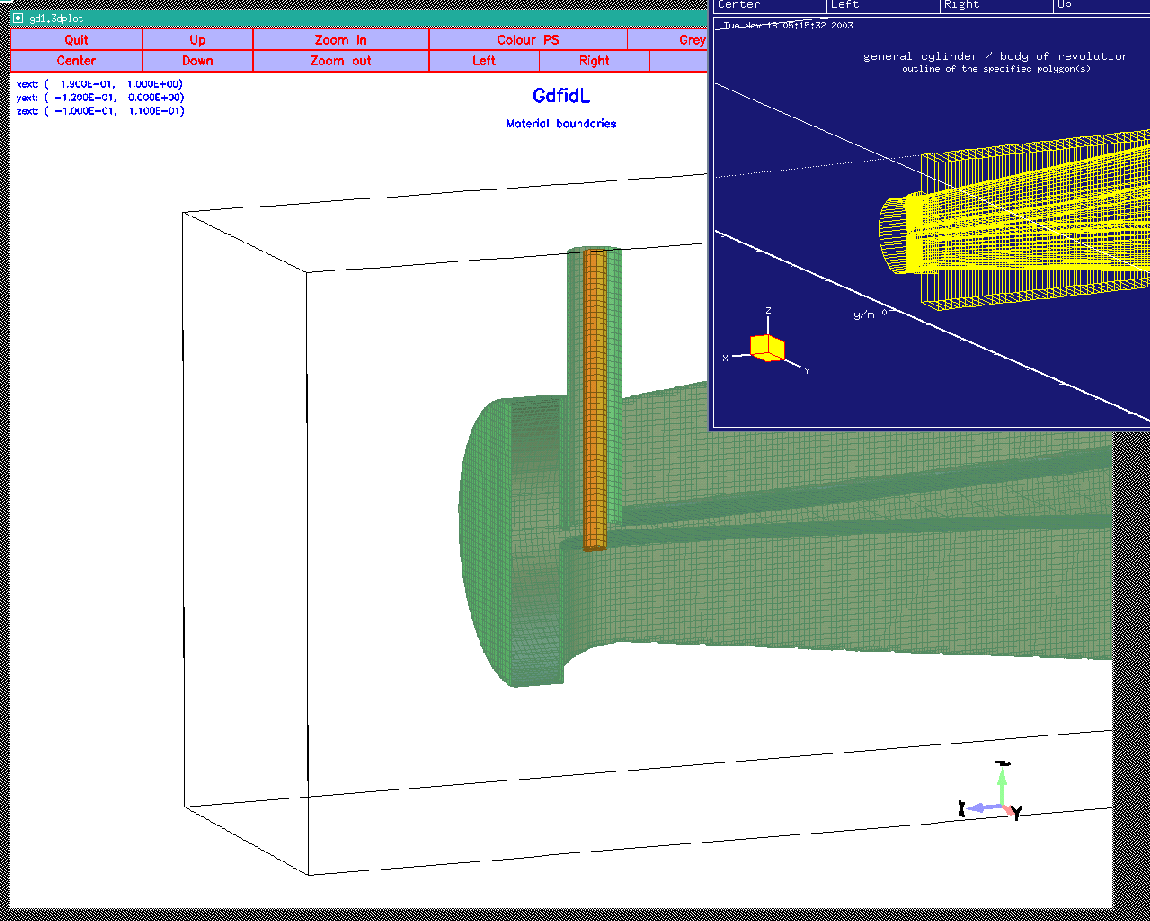 |
-general
outfile= /tmp/UserName/bessy-cavity
scratch= /tmp/UserName/bessy-scratch-
dice= yes # If computing in parallel, use the subvolume algorithm
## ndpw= 24 # use 24 subvolumes per CPU
iodice= yes # store the results on the local discs of the nodes
-material
material= 3, type= electric
material= 4, type= electric
define(STPSZE, 2e-3)
-mesh
spacing= STPSZE
#
# The borders of the computational volume:
#
define(YLOW, -0.94)
define(YHIGH, 0)
pxlow= -0.6, pxhigh= 1.0
pylow= YLOW, pyhigh= YHIGH
pzlow= -0.2, pzhigh= 0.2
#
# The conditions at the borders:
#
cxlow= electric, cxhigh= electric
cylow= electric, cyhigh= magnetic
czlow= electric, czhigh= electric
-brick
material= 3
volume= ( -INF,INF, -INF,INF, -INF,INF )
doit
include( macro-Linear_Waveguide.gdf )
include( macro-Linear_Ridge.gdf )
include( macro-transformer-and-coaxial.gdf )
#
# Call the macros three times:
#
do iPhi= 1, 3
if (iPhi == 3) then
sdefine(SHOW, all)
else
sdefine(SHOW, later)
endif
if (iPhi == 1) then
define(ZPOS, 0.0495)
else
define(ZPOS, -0.0495)
endif
define(Phi, 0+(iPhi-1)*120)
#
# constant radius section of the circular part:
#
call Linear_Waveguide(Phi, \ # angle
ZPOS, \ # z-position
170e-3, \ # starting position of the ggcylinder
100e-3, \ # start value outer radius
375e-3, \ # end position of the ggcylinder
100e-3, \ # endvalue of the outer radius
later )
#
# constant section of the ridge:
#
call Linear_Ridge(Phi, \ # angle
ZPOS, \ # z-position
200e-3, \ # starting position of the ggcylinder
43e-3, \ # start value half gap
375e-3, \ # end position of the ggcylinder
9e-3, \ # endvalue of half gap
later )
#
# linear varying section:
#
call Linear_Waveguide(Phi, \ # angle
ZPOS, \ # z-position
375e-3, \ # starting position of the ggcylinder
100e-3, \ # start value outer radius
875e-3, \ # end position of the ggcylinder
50e-3, \ # endvalue of the outer radius
later )
#
# constant radius section, the part where the transformer is in
#
call Linear_Waveguide(Phi, \ # angle
ZPOS, \ # z-position
875e-3, \ # starting position of the ggcylinder
50e-3, \ # start value outer radius
(875e-3+65e-3), \ # end position of the ggcylinder
50e-3, \ # endvalue of the outer radius
later )
#
# Model the non-linear ridge via the many calls:
#
include( non-linear-ridge.gdf )
#
# Model the transformer and the coaxial line:
#
call transformer_and_coaxial(Phi, ZPOS, SHOW )
#
# tell GdfidL that the coaxial lines
# shall be treated as ports.
#
define(XX, 900e-3*cos(Phi*@pi/180) )
define(YY, 900e-3*sin(Phi*@pi/180) )
if (YY+50e-3 >= YLOW) then
if (YY-50e-3 <= YHIGH) then
#
# Only specify the port
# if at least a part of it
# is really within the computational volume
#
-fdtd
-ports
name= coax-phi=Phi, plane= zhigh, npml= 20, modes= 1
pxlow= XX-50e-3, pxhigh= XX+50e-3
pylow= YY-50e-3, pyhigh= YY+50e-3
doit
endif
endif
enddo # iPhi-loop
#
# tell GdfidL that the beam-pipes
# shall be treated as ports.
#
-fdtd
-ports
name= beamlow, plane= zlow, npml= 40, modes= 0
pxlow= -100e-3, pxhigh= 100e-3
pylow= -100e-3, pyhigh= 100e-3
doit
name= beamhigh, plane= zhigh, npml= 40, modes= 0
pxlow= -100e-3, pxhigh= 100e-3
pylow= -100e-3, pyhigh= 100e-3
doit
#
# Model the cavity itself:
#
include(Cavity.gdf)
-volumeplot
doit
#
# Specify that we want to perform a wakepotential-computation:
#
-fdtd
-lcharge
charge= 1e-12
xposition= 0
yposition= 0
sigma= 5*STPSZE
shigh= 400
#
# start the computation:
#
-fdtd
doit
This is the end of this tutorial.